If you've taken basic math and only basic math the answer is 288.
If you've taken basic algebra or any more mathmatics beyond basic math then the answer is 2.
48 / 2(9+3)
n(x+y) is an simplified expression using coefficents.
unsimplified it is ((n*x)+(n*y))
so unsimplified the equation is written
48 / ((2*9)+(2*3))
48 / 24
2
n(x+y) is the basis of all more complex mathmatic, functions, and graphing seen through Algebra to statistics to complex theoritical math.
---
On the Other hand...
if you use only 'Basic math' (ie- What most all computer programs use)
the equation should be split up
48/2*(9+3)
24*(12)
288
Google calculator will give you this answer.
i will point out, Google calculator isn't the end all-be-all answer to everything.
example:
2^3^4
to google calculator will show the answer 24 septillion... (2.4 x 10^24)
however, using standard order of operations... you should get the answer 4096
If you've taken basic algebra or any more mathmatics beyond basic math then the answer is 2.
48 / 2(9+3)
n(x+y) is an simplified expression using coefficents.
unsimplified it is ((n*x)+(n*y))
so unsimplified the equation is written
48 / ((2*9)+(2*3))
48 / 24
2
n(x+y) is the basis of all more complex mathmatic, functions, and graphing seen through Algebra to statistics to complex theoritical math.
---
On the Other hand...
if you use only 'Basic math' (ie- What most all computer programs use)
the equation should be split up
48/2*(9+3)
24*(12)
288
Google calculator will give you this answer.
i will point out, Google calculator isn't the end all-be-all answer to everything.
example:
2^3^4
to google calculator will show the answer 24 septillion... (2.4 x 10^24)
however, using standard order of operations... you should get the answer 4096

